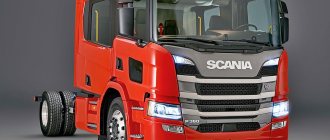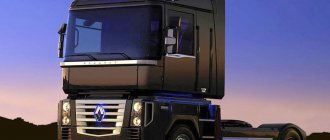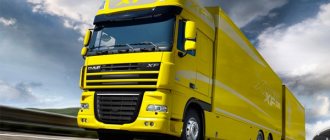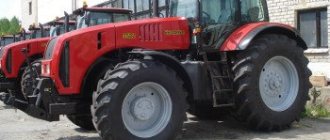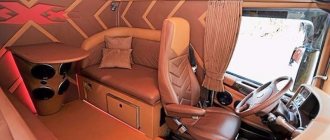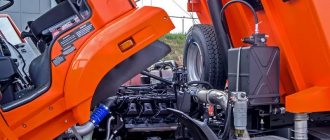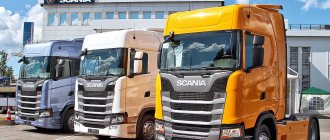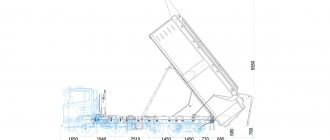- Scania's modular system provides the basis for customer-centric solutions
- New driver's seat provides increased flexibility and safety
- Focuses on comfortable driving and ergonomic design
- Level of quality, fit and materials rivals that of passenger cars
- The cabin is divided into two zones, each with individual functions and lighting
When Scania developed the cabs of the new range of trucks, the goal was to take as a basis and improve the interior design of the already proven P, G and R cabs. The new generation of Scania cabs used all the accumulated experience in this field, and also took into account the results of hundreds of press tests, suggestions from customer service stations and, no less important, driver reviews.
The result of such a synthesis has the potential to set a new standard in the industry. “The main challenge is to create a flexible range of cabs that can provide the right solutions and the right tools for every possible purpose,” says Göran Hammarberg, Head of Cab Development at Scania. “While requirements may vary radically depending on the task at hand and driving conditions, our goal is to convince every driver that no one else can provide better solutions and driving conditions.”
Scania sees the solution to this problem in a modular system, a concept thanks to which the company is always able to offer high-quality, tailored solutions based on a relatively small number of base models.
Scania's modular approach is a very important component of customer satisfaction, as it allows the company to provide quality, tailored solutions regardless of each customer's specific application and requirements. The modular system also simplifies parts supply, getting customers' trucks back on the road faster after repairs.
“The modular system is one of the most important components of customer satisfaction because it provides unique options to solve their operational problems. At the same time, this means that, for example, in the event of a breakdown, everything is taken into account: from delivery times to the cost of repairs, emphasizes Goran Hammarberg. “Of course, this also helps to ensure maximum overall efficiency for Scania customers.”
Driver-centric
Of course, the interiors of the new cabs have been designed to provide optimal comfort for the driver while driving and relaxing. There are now even more options for adjusting the driver's seat: all drivers with a height of 150 to 200 cm will be able to choose the most comfortable seating position. Moreover, both front and side visibility have been improved by moving the driver's seat closer to the windshield and slightly to the left. Much effort has also been put into the design of the cab's A-pillars to optimize side visibility. The dashboard has been lowered slightly compared to previous models, greatly improving visibility in front of the truck.
Particular attention was paid to ensuring that each driver had enough knee and leg room, even if they were wearing warm, thick clothing and large boots. The redesigned instrument panel also makes it easier to move around inside the cabin when the vehicle is parked.
The interior of the new Scania cabs is characterized by premium quality and almost limitless flexibility. Whether the driver needs two refrigerators, hundreds of liters of storage capacity or a bed of maximum comfort, Scania always has the solution.
“The exterior design has been thought through just as carefully as the interior design,” said Kristofer Hansén, Scania's chief designer and the man behind the exterior design of the new generation of trucks. “When you step into the cab, you should immediately, without thinking, understand that this is a Scania car. The dashboard design is accessible and functional, with curved lines that help guide the eye and even the hands in a way that feels safe. We're laser-focused on creating a design that helps drivers get the job done. At the same time, we also tried to stay within the boundaries and avoid being too busy, so that it doesn't look old-fashioned."
Efficient use of space
Important functions can be provided by built-in automation, such as rain sensors. Other, simpler requirements can be met with ergonomic design, where everything from chilled drinks to mobile phones is at hand in easy-to-reach storage areas. The external side storage container in larger cabs is equipped with a 410 x 570 mm hatch and can be reached from the cab.
Storage spaces are designed with a focus on accessibility and flexibility, and can be complemented with features such as shelves, hooks and nets to suit everyone's needs.
There are even more options for storage space, with a special emphasis on volume and accessibility. The cabin layout is carefully thought out and space is used efficiently down to the last detail. Depending on the cabin option, the chosen bed and other specific needs, you can choose a variety of storage containers, hooks and nets. There is a particularly wide selection when it comes to beds. Lower beds, like upper beds, have different designs and functionality depending on specific wishes and comfort requirements.
“The S cab can accommodate two 80 cm beds (the lower of which can be extended to 100 cm) with our latest mattresses: for example for long-haul vehicles with two drivers,” explains Goran Hammarberg, Head of Cab Development at Scania. “So no one has to make do with an uncomfortable bed, and both drivers can sleep in optimal conditions. The spacious S-cabins are also extra insulated, and every detail is carefully engineered to ensure a comfortable sleeping environment. Moreover, the flat floor of the S-type cabs makes it easy to move around inside.”
Engine characteristics of Scania R730 V8
In its very name, the Scania R730 V8 model demonstrates one of the engine characteristics - 730 horsepower.
More on the topic: Photon 1099: reviews, characteristics, tests
| Engine, volume, l | Diesel, 16.4 l |
| engine's type | V-shaped |
| Number of cylinders, pcs. | 8 |
| Number of valves, pcs. | 32 |
| Engine power, l/s | 730 |
| Torque, Nm | 3500 |
| Rotation speed, rpm | 1500 |
| Fuel consumption, per 100 km, l | 44 |
| Supercharging | Holzet |
| Maximum speed, km/h | 210 |
| Fuel tank, volume, l | 500 |
| Transmission | Automatic transmission Scania Opticruise, 12+2 |
But one should not assume that the versatile approach of the Scania R730 V8 developers is limited by the variability of platforms. The same variability is also present in the variety of engine groups that can be installed on the Scania R730 V8 model range. Don't forget that the Scania R730 V8 is a branded “bird”. Depending on the wishes of the customer, motors can have a herd power from 400 to 750 l/s. By the way, the most economical is the new generation of engines 410-580 l/s, where the exhaust gas recirculation system (EGR) and the injection system of synthetic ammonia into the exhaust mixture in a volume of 1.5 liters per 100 km (SCR) bring the average fuel consumption to 29 .4 liters (!) per 100 km of driving with pleasure. The company is already testing new engines using compressed and liquefied gases (CNG and LNG).
Scania R730 engine hugging a turbine
It would not be superfluous to mention that the turbine is located directly in the center of the engine, at the base of the divergence of the heads, and the heads are divided by the pistons. This is a Södertälä classic. Repairing such a “strongman” does not cause problems for service centers, since many components and internal working parts of the engine have unified standards and there is no need to individually select, for example, a piston group for each engine. An oil change becomes extremely necessary only after reaching 60 thousand km.
If you need to look under the hood of the “king”, or rather under the driver’s seat, then to do this you need to fold back the front grille. It is under it that the manual pumping valve for the cabin tilting oil pump is located. These manipulations eliminate incorrect actions when tilting the cabin, serve as a reminder of safety measures and the urgent need to “ventilate” the turbine.
Transmission Scania R730 V8
The comfort and pleasure of driving such an Atlante is ensured by the Opticruise automatic transmission. Like the Scania R730 V8 itself, the embodiment of the fastest and most powerful production iconic truck, the automatic transmission is the eyes, ears and thoughts of the driver. Despite the automatic nature of gear shifting and the lightning speed of acceleration, to secure the driver’s actions, a lever for manually switching modes and gears is located on the right under the steering wheel. The robot box itself adapts to the conditions of the track.
Additional sensors, devices and mechanisms have a positive effect on the operation of the transmission in absolutely any conditions. For example, the longitudinal inclination sensor of the road surface (like in an airplane!) tells you when and which gear to select in accordance with the weight of the load and the speed of movement, in order to overcome a long climb as “easily” as possible or, conversely, carefully roll down, braking with drum brakes. The anti-slip system and the Retard system allow the robotic box to independently select maneuvering or power mode, and select the desired speed to overcome areas with a muddy dirt road.
The input shaft of the Scania Opticruise robot is under the constant control of a hydraulic retarder, which “rubs” with it in the same housing. The transmission not only thinks, drives and makes decisions, it also reports to the driver. It displays its every-second reports on the electronic display, which is located in the center of the dashboard, exactly between the beams of the steering wheel!
Driver and Scania R730 V8 - heart-to-heart talk
To the satisfaction of current and future Russian drivers, the electronic display can be in Russian. Scania AB designers have done everything to ensure that the traditions of cooperation with Russia, begun in 1915, continue today!
Absolute freedom
In the new cabins, even the dashboard is modular, which allows it to be adjusted to the needs of the client, in particular, the ergonomic design, buttons, switches and storage locations can be changed depending on needs. It is also worth noting that all materials, tolerances and gaps between parts are made at the same level as in passenger cars. “The standard, quality and fit of the coatings have been taken to a whole new level among truck manufacturers, but all parts must be as reliable as before and remain functional throughout the life of the truck,” emphasizes Christopher Hansen.
The instrument panel is also modular and can be adjusted to individual requirements and wishes. Each version of the cabin is characterized by high quality, previously characteristic only of passenger cars.
Anyone who has ever driven a Scania will feel right at home in the driver's seat, even though everything is brand new.
“Of course, we changed the fundamentals of ergonomic design for a reason: we used all the experience gained over the years at Scania,” said Fredrik Pehrsson, Head of Vehicle Ergonomics. “For example, there are now many different options depending on how you want to organize your storage space. Whether you choose the S cab with a flat floor or the R Series day cab with an emphasis on durability, you will notice that all the materials in the cabs are of the highest quality.”
The modular design also includes buttons and switches that are an important part of the truck driver's work environment. Thanks to the modular design, each driver can customize their work station based on the most important requirements and functions for a specific truck or task.
“You will have even more opportunities to change and customize everything for yourself. Ergonomic design and a wide range of colors and materials create a comfortable workspace of the best quality, explains Christopher Hansen, Chief Design Officer at Scania. — At the same time, the interior is scratch-resistant and can withstand even the most thorough cleaning. For example, switches installed in doors are designed to resist exposure to water and dust, including long-term exposure.”
After nine hours of driving, it's nice to be able to relax in front of the TV before bed. In the cabin you can fit a comfortable swivel chair, wiring and other necessary infrastructure for the TV.
An additional option is a passenger seat that can swivel and recline for greater ergonomics and comfort in the cabin. There are a variety of interior lighting options available, allowing users to dim the lights and change the ambiance. Lightproof curtains have also been improved: they are made from new material and have become easier to use. The interior sun visors can be lowered individually and are easily adjusted on the go thanks to a convenient mechanism.
New Scania cab concepts
A. Mamedov
At last year's show in Amsterdam, Scania unveiled two very interesting cab concepts for long-haul trucks. One of them is fully implemented in Longline cabins, which provide exceptional comfort to the crew on ultra-long flights and have already become available to consumers. The second concept, which increases the degree of passive safety of tractors, has yet to prove its relevance. It is interesting to note that both new products, which will be discussed below, are very relevant for Russian road trains. So, we present the first new product...
House on wheels
Having aroused great interest as a concept car, the experimental Scania eXc long-haul tractor with a cabin extended by 1,300 mm was launched by the Swedish company Laxa Special Vehicles, which has been closely cooperating with the Scania concern for 20 years. The demonstration of the Scania eXc as a concept at the 2002 Hannover Motor Show raised a lot of questions among experts. As you know, tractor-trailers with huge living compartments are not popular in Europe, but they enjoy well-deserved respect among US “truck drivers” who travel long distances without stopping in motels and are forced to spend the night in truck cabins. In response to questions like “who are you going to produce these machines for?”, Scania representatives presented the results of marketing research that proved the prospects and timeliness of such a development.
It turns out that a similar cabin is expected by the company’s dealers operating not only in the USA, but also in Australia and some Asian countries; it will also be offered to Russian transport workers. The rapid development of transcontinental transportation, including from Southeast Asia to Europe, poses the task of tractor manufacturers to radically ease the working conditions of crews who spend long periods on flights and do not have the opportunity to enjoy the “fruits of modern civilization.”
The new cab, designated Longline in standard version, has been installed since 2004 on Scania tractors with a wheel arrangement of 4x2, 6x2, 6x2/4 (the rear wheels of the trolley axle are steered), as well as 6x4. The design of the cabin is unified with the Topline Sleeper cab, but is 1,300 mm longer. The distance from the tractor bumper to the rear wall of the cab is the same as for a Scania T-series bonneted tractor with a sleeper cab. The length of the tractor is also fully consistent with the Scania T tractor with a similar wheel arrangement. For some European countries, the operation of road trains with such “long” tractors is only possible together with special shortened semi-trailers. Naturally, all the main advantages of such cabins can only be realized in countries where legislation allows the operation of especially long road trains.
Speaking about the interior of the Longline, it can be noted that its front part with the driver’s workplace has not undergone any changes. The “living” area behind the seats is striking with a room height of 2,300 mm. Light enters the cabin through the side windows and huge hatches in the roof, and in the dark the “room” is flooded with electric light from numerous lampshades. The lower bed has dimensions increased to 900x2,000 mm. The top shelf, located above the driver's seat, is 900 mm wide.
There is a special table for eating, and you can wash your hands using a washbasin with a tap and a special water tank. There are many drawers, shelves and niches around for items needed on a long flight. Equipment in the “living” area includes a TV, audio system, DVD player, microwave oven, coffee grinder, and refrigerator. The navigation system provides access to the Internet, and the safe will help protect documents and valuables that are best kept under seal.
The increase in cabin volume required increased efficiency of the heating and air conditioning systems. Special thermal insulation helps retain heat longer. The suspension of the cab to the frame has also undergone corresponding changes. When parked, the cabin electrical equipment can be connected to an external power source. Buyers are offered tractors with Longline cabs equipped with 580-horsepower V8 diesel engines and a Scania Opticruise gearbox with automated gear shifting. It is still unknown how much the new cabin will increase the price of the car.
In the name of safety
At the Traffic Safety Conference held by Scania in Brussels in October last year, the company’s specialists made a report on a new cab concept for long-haul tractors, the introduction of which could save at least 900 people annually in car accidents. The main feature of such a cabin is the front overhang of the car increased by 600 mm due to the creation of a special zone that is deformed during frontal collisions. Sketches, drawings and a scale model of a tractor with a similar type of cab were shown, which aroused great interest.
Eric Dahlberg, the “father” of the new concept, talked about how modern underrun protection installed on tractors is effective in a collision between a car and a truck if their combined speed does not exceed 60 km/h. Only in this case do the people sitting in the car have a chance to survive. Increasing the deformable zone from 200 mm - this is how the truck bumper is deformed, absorbing the impact - to 600 mm, increases the mutual speed of “survival” in the event of a collision between a car and a truck to 90 km/h.
There are serious obstacles on the way of an idea to the factory assembly line. The first is the current legislation, which limits the length of the road train and forces, in the case of using a tractor with a new cab, to reduce the useful volume of the semi-trailer body. The second, purely technical, is to create a deformable structure of the front of the cabin that most effectively absorbs impact energy. Naturally, designers will also have to make efforts here to preserve corporate features in the design of the cabins, as well as create a new expressive, dynamic and, at least, not causing a negative perception from others, design project for the cabin, conventionally called “short-hood”.
The following figures will help you understand how relevant the introduction of new cabins is to the continent’s road transport. Every year, 4,000 people die as a result of frontal collisions between cars and trucks in EU countries alone. In 90% of cases, the cause of the accident is a car entering the oncoming lane while overtaking. Experts believe that the introduction of underrun protection on tractors, which has been included in European safety standards since August 2003, can reduce the number of disaster victims by 900 people annually, plus at least 900 more people should remain alive after the introduction of “short-bonnet” cabs on long-haul trucks. trucks. In any case, engineer Eric Dahlberg sincerely believes that soon the example of Scania will be supported by other global truck manufacturers who will begin testing vehicles with “short-hood” cabs, and then his idea will finally take off.
Comfortable climate
Scania has also developed completely new climate systems. This is a very important development, which, perhaps more than any other, helps to create ideal driving conditions, which is something of a Scania calling card. Thanks to new automatic or manual climate control systems, it is the driver, and not the external conditions, who ensures comfort both while driving and while resting.
“A well-functioning climate system is the dividing line in the truck industry,” said Goran Hammarberg, Head of Cab Development at Scania. “This is not an easy task, given that the cabin has a relatively large volume of air, which is affected by external temperature and heat radiation from large windows. We have also integrated a number of sensors such as light, humidity and air quality sensor. In the new generation of cabs, the driver and only the driver decides where and when the temperature should be high, low or moderate.”
Additional heaters can be installed in any cab, and a fully integrated air intercooling system can be ordered directly from the factory. It is integrated into a standard climate system so that heated or cooled air passes through special ducts and is controlled using a standard climate control panel. This ensures a more even climate, quieter operation of the system and uniform distribution of the desired temperature. Additional heaters are available with remote control and can also be used with alternative fuels.
Thanks to increased cabin insulation, new vehicle climate systems consume less energy, which has a positive effect on fuel consumption. Of course, the systems are tuned to minimize energy consumption. Much attention was paid to reducing the cost of operating climate systems and add-ons for them. It is also important to improve the operation of glass defoggers and defogging systems. And one more feature that provides additional comfort is the ability to order cars with a heated windshield.
Development of the Scania cab interior
| 1950 |
1950
Beautiful, but not very practical. The panel is mostly painted metal, which looks good, but unfortunately was very reflective in sunny weather. The dials were surrounded by chrome, in a classic style, the same style that designers use today to find new ideas. The dashboard was located vertically, like on modern trucks.
| 1960 |
1960
The main change here is a more comfortable steering wheel and dashboard. But, as in the 1950s, the buttons are small and unmarked. The seat has no suspension and the steering column is not adjustable; long trips have always meant fatigue for the driver.
| 1970 |
1970
Long-haul flights always involve living in the cabin, and we are seeing that designers are increasingly paying attention to the concerns of drivers. The panel is made from soft, black plastic, which gives the cabin a touch of luxury. The second, main function of soft plastic is impact protection. For the first time, large keys with symbols printed on them were used. The designers took care of the central tunnel and created a compartment for storing personal belongings. The innovation ultimately did not catch on, as it made it difficult to move around the cabin.
| 1980 |
1980
With the introduction of the 3 Series we really see big changes, with the curved dashboard being used for the first time in a Scania vehicle. The truck driver has literally moved from the truck cab to the airplane cockpit, and is now a style icon. More and more luxury and amenities are appearing in the interior: air seat suspension, an adjustable steering column, an abundance of soft and more expensive plastic.
| 1990 |
1990
We see a continuation of the curved line of the panel, which makes it easier and more convenient to access the ever-growing row of function buttons. The center console still exists.
| Today |
Today
The height of luxury and comfort, lots of textiles and soft plastics create a pleasant environment for working and living in the Scania cab. Many important control functions have moved to the steering wheel. Armchairs with an optimal range of adjustments, air suspension and integrated seat belts for additional comfort. Wide armrests allow you to take any comfortable position for the driver.
| A designer's look into the future of the Scania cab interior |
Review and photos courtesy of Scania
translation: Blog Trucker
16.01.2013
Highest sound quality
There's also a lot to choose from when it comes to infotainment systems. It all comes down to two well-integrated systems with either 5" or 7" screens. Integrated steering wheel switches are standard, as is voice control via the roof microphone.
“Of course, both systems have AUX and USB connections and allow the connection of up to two external devices, for example the driver’s and carrier’s mobile phones simultaneously connected via Bluetooth,” explains Göran Hammarberg.
— The large model has two camera inputs. Both systems come with four speakers as standard, with the option to add a center and subwoofer speakers. For sleeper cabs, it is possible to order sequential installation of equipment, such as a TV, directly from the factory.
Modern infotainment systems are an important part of a driver's workday. In addition to functions such as music and navigation, communication with the “home” base is also important, since it can be connected to the fleet management system of the transport company. The screen can also be used to transmit security messages from special cameras.
“In terms of functionality, truck infotainment systems correspond to the latest standards for systems in passenger cars, but of course with increased reliability,” said Anna Selmarker, Head of HMI (Digital Human-Machine Interaction) at Scania . “Advancement in this area is happening quickly, so we plan to gradually add new features through connected services and ADAS (Advanced Driver Information Systems) options in the future.”
Cabin Scania R730 V8
To even say that the Scania R730 V8's cabin is luxurious is an understatement. The designers followed the path of optimal necessity and comfortable functionality. Compared to previous Scania "R" series tractor models, the Scania R730 V8 has many external changes. This includes a grille spread across the hood, improved streamlining due to a change in the angle of resistance of the front part, a front part extended forward by 13.5 cm, a front bumper moved forward 8 cm, direction indicators outside the bumper, and protective trim on the headlights. with dirt cleaners, and a separate bumper mount, and stylish air intakes, and directional mirrors, and thin, durable A-pillars that do not reduce visibility. All these elements ultimately contribute to safety and driving comfort.
More on the topic: Japanese twins: Toyota Dune and Toyota Toyota Ace
Scania R730 V8 Streamline, Topline, Highline, Longline
Particularly worth mentioning is the interior of the Scania R730 V8, like apartments on wheels for a truck driver. Leather ergonomic seats allow the truck driver to sit like in a car, with armrests and a control panel. Without changing your driving position, you can turn on the radio, open the windows or sunroof, and control the air conditioning.
High-quality plastic on the door panels, front panel and simple but reliable design of the folding table opposite the folding passenger seat. Soft, even light from the central ceiling lamp and the lamp on the visor, a steering wheel with wooden inserts (not every small car has such a steering wheel), curtains on the windows, pleasant-to-touch interior upholstery. Chic, and that’s all!
Cabin types
All Scania R730 V8 cab types are spacious and offer plenty of interior space. Compactly located in the canopy and front panel, a folding table, shelves, cabinets and a compartment under the lower berth accommodate a refrigerator with freezer, a microwave oven, and a coffee maker. Of course, these devices come with Scania Topline keys and are included in the price of the tractor. The constant height inside the cabin is 2.2 m, width – 2.13 m, depth from the windshield – 2.2 m. The lower berth with a width of 0.8 m is located at a height of 0.39 m from the floor and consists of a wooden structure with orthopedic lamellas. To climb onto the top shelf with a distance of 0.6 m from the ceiling behind the driver, a folding profile ladder is provided. Everything is thought out to the smallest detail in the simple and most comfortable Topline interior.
Topline cabin and interior dimensions
Life inside Topline
With all the similar signs of civilization and a two-meter length of shelves for rest, the overall height of the Scania Highline tilting cab is 0.32 m lower. Accordingly, all height parameters will be smaller compared to the Topline option. The upper orthopedic “bed”, when unfolded, almost rests on the headrest of the driver’s seat, but the height of 0.7 m between the shelves is sufficient for a comfortable rest.
Interior dimensions of Scania Highline
It makes no sense to describe the interior of the Scania R730 V8 Longline cabin. This is the case when photos are better than words.
Scania R730 V8 Longline before tuning
The Scania R730 V8 Streamline cabin is based on Topline and is equipped with a large number of external fairings, bumpers and deflectors, which not only push away visible and invisible flows and enhance aerodynamic characteristics. This is a cab model equipped with the maximum number of additional options related to fuel economy and services for the driver. Maximum speed and comfort with maximum savings - this is the motto of the Scania R730 V8 Streamline.
Options Scania R730 V8 Streamline
- The second generation of engines, in accordance with Euro-6 standards, saves up to 8% of fuel.
- The already very smart cruise control has been enriched with an economical mode.
- Electronic kits for monitoring the roadside area in front of the hood, monitoring brake control, navigation, remote diagnostics of the “health” of the truck with data transfer to the service center.
Everything is created for people, everything is created for work, everything is created for comfortable work of people on long-distance transport!
Matte chic interior of Scania R730 V8
Leading in class
The new cabs from Scania are developed based on the wealth of information the company has accumulated as a leading manufacturer about the needs and wishes of truck drivers. At the first stage of production, Scania offers eight different cab variants, but the range will be quickly expanded with new models. But which of the innovations for the new line of cabins is the most important?
The design of Scania cabs is based on the knowledge and experience gained from the company's many years as a leading manufacturer. Paying close attention to the needs of each individual case is a significant part of Scania's work and is also an important factor that can impact a customer's profitability in the long term.
“We don’t single out one thing,” says Goran Hammareberg. “Every little detail affects the overall practicality, and ultimately it is the client’s needs that determine the result and technical characteristics. This time we were able to start from scratch, using our accumulated experience as a springboard. We are well equipped to offer tailor-made solutions for every Scania customer, no matter the complexity of the requirements or challenges.”

